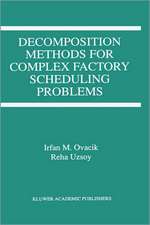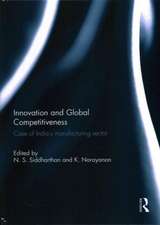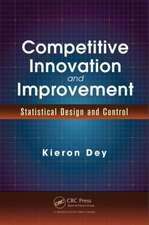Six Sigma with R: Statistical Engineering for Process Improvement: Use R!, cartea 36
Autor Emilio L. Cano, Javier Martinez Moguerza, Andrés Redchuken Limba Engleză Paperback – 5 iul 2012
The aim of this book is to show how R can be used as the software tool in the development of Six Sigma projects. The book includes a gentle introduction to Six Sigma and a variety of examples showing how to use R within real situations. It has been conceived as a self contained piece. Therefore, it is addressed not only to Six Sigma practitioners, but also to professionals trying to initiate themselves in this management methodology. The book may be used as a text book as well.
Din seria Use R!
- 15%
 Preț: 676.86 lei
Preț: 676.86 lei - 17%
 Preț: 362.75 lei
Preț: 362.75 lei - 15%
 Preț: 591.79 lei
Preț: 591.79 lei - 17%
 Preț: 362.16 lei
Preț: 362.16 lei - 17%
 Preț: 461.37 lei
Preț: 461.37 lei -
 Preț: 226.74 lei
Preț: 226.74 lei - 17%
 Preț: 395.94 lei
Preț: 395.94 lei -
 Preț: 374.87 lei
Preț: 374.87 lei - 20%
 Preț: 500.66 lei
Preț: 500.66 lei - 17%
 Preț: 396.92 lei
Preț: 396.92 lei - 15%
 Preț: 360.59 lei
Preț: 360.59 lei - 17%
 Preț: 430.21 lei
Preț: 430.21 lei -
 Preț: 276.09 lei
Preț: 276.09 lei - 15%
 Preț: 497.12 lei
Preț: 497.12 lei - 15%
 Preț: 471.53 lei
Preț: 471.53 lei - 15%
 Preț: 525.35 lei
Preț: 525.35 lei -
 Preț: 489.30 lei
Preț: 489.30 lei - 15%
 Preț: 523.07 lei
Preț: 523.07 lei -
 Preț: 455.89 lei
Preț: 455.89 lei - 15%
 Preț: 518.73 lei
Preț: 518.73 lei - 18%
 Preț: 835.24 lei
Preț: 835.24 lei - 15%
 Preț: 498.94 lei
Preț: 498.94 lei - 18%
 Preț: 783.35 lei
Preț: 783.35 lei - 18%
 Preț: 783.20 lei
Preț: 783.20 lei - 15%
 Preț: 523.91 lei
Preț: 523.91 lei -
 Preț: 484.47 lei
Preț: 484.47 lei -
 Preț: 420.40 lei
Preț: 420.40 lei - 15%
 Preț: 523.07 lei
Preț: 523.07 lei -
 Preț: 419.06 lei
Preț: 419.06 lei - 15%
 Preț: 695.70 lei
Preț: 695.70 lei - 15%
 Preț: 499.12 lei
Preț: 499.12 lei - 15%
 Preț: 493.89 lei
Preț: 493.89 lei - 15%
 Preț: 584.10 lei
Preț: 584.10 lei - 15%
 Preț: 591.47 lei
Preț: 591.47 lei - 15%
 Preț: 497.31 lei
Preț: 497.31 lei - 15%
 Preț: 696.02 lei
Preț: 696.02 lei -
 Preț: 420.02 lei
Preț: 420.02 lei -
 Preț: 489.87 lei
Preț: 489.87 lei - 15%
 Preț: 579.66 lei
Preț: 579.66 lei -
 Preț: 486.42 lei
Preț: 486.42 lei - 15%
 Preț: 507.95 lei
Preț: 507.95 lei -
 Preț: 388.34 lei
Preț: 388.34 lei - 15%
 Preț: 496.67 lei
Preț: 496.67 lei -
 Preț: 423.47 lei
Preț: 423.47 lei - 15%
 Preț: 520.61 lei
Preț: 520.61 lei - 15%
 Preț: 531.26 lei
Preț: 531.26 lei - 15%
 Preț: 576.52 lei
Preț: 576.52 lei -
 Preț: 454.16 lei
Preț: 454.16 lei
Preț: 579.16 lei
Preț vechi: 681.37 lei
-15% Nou
Puncte Express: 869
Preț estimativ în valută:
110.82€ • 120.76$ • 93.38£
110.82€ • 120.76$ • 93.38£
Carte tipărită la comandă
Livrare economică 23 aprilie-07 mai
Preluare comenzi: 021 569.72.76
Specificații
ISBN-13: 9781461436515
ISBN-10: 1461436516
Pagini: 316
Ilustrații: XXX, 284 p. 104 illus., 26 illus. in color.
Dimensiuni: 155 x 235 x 23 mm
Greutate: 0.44 kg
Ediția:2012
Editura: Springer
Colecția Springer
Seria Use R!
Locul publicării:New York, NY, United States
ISBN-10: 1461436516
Pagini: 316
Ilustrații: XXX, 284 p. 104 illus., 26 illus. in color.
Dimensiuni: 155 x 235 x 23 mm
Greutate: 0.44 kg
Ediția:2012
Editura: Springer
Colecția Springer
Seria Use R!
Locul publicării:New York, NY, United States
Public țintă
Professional/practitionerCuprins
Part I Basics.- Six Sigma in a Nutshell.- R from the Beginning.- Part II R Tools for the Define phase.- Process Mapping with R.- Loss Function Analysis with R.- Part III R Tools for the Measure phase.- Measurement System Analysis with R.- Pareto Analysis with R.- Process Capability Analysis with R.- Part IV R Tools for the Analyze phase.- Charts with R.- Statistics and Probability with R.- Statistical Inference with R.- Part V R Tools for the Improve phase.- Design of Experiments with R.- Part VI R Tools for the Control phase.- Process Control with R.- Part VII Further and Beyond.- Other Tools and Methodologies.
Recenzii
From the book reviews:
“The reviewed book deals with the use of R software within six sigma methodology. … To help a practitioner read this book, the authors conclude each chapter with a summary and further reading, case studies, and practical exercises. … The authors have combined their scientific, technological, industrial, and pedagogical skills so that the reader finds in the book an innovative, rigorous, and economical way to apply Six Sigma methodology to continuous quality improvement.” (Adriana Horníková, Technometrics, Vol. 55 (1), February, 2013)
“The reviewed book deals with the use of R software within six sigma methodology. … To help a practitioner read this book, the authors conclude each chapter with a summary and further reading, case studies, and practical exercises. … The authors have combined their scientific, technological, industrial, and pedagogical skills so that the reader finds in the book an innovative, rigorous, and economical way to apply Six Sigma methodology to continuous quality improvement.” (Adriana Horníková, Technometrics, Vol. 55 (1), February, 2013)
Notă biografică
Emilio L. Cano is Adjunct Lecturer at the Department of Mathematics at University of Castilla-La Mancha and Research Assistant Professor at the Department of Statistics and Operations Research at University Rey Juan Carlos.
Javier M. Moguerza is Associate Professor in Statistics and Operations Research at University Rey Juan Carlos and member of the Global Young Academy.
Andres Redchuk is Master Black Belt and Research Assistant Professor at the Department of Statistics and Operations Research at University Rey Juan Carlos.
Javier M. Moguerza is Associate Professor in Statistics and Operations Research at University Rey Juan Carlos and member of the Global Young Academy.
Andres Redchuk is Master Black Belt and Research Assistant Professor at the Department of Statistics and Operations Research at University Rey Juan Carlos.
Textul de pe ultima copertă
Six Sigma has arisen in the last two decades as a breakthrough Quality Management Methodology. With Six Sigma, we are solving problems and improving processes using as a basis one of the most powerful tools of human development: the scientific method. For the analysis of data, Six Sigma requires the use of statistical software, being R an Open Source option that fulfills this requirement. R is a software system that includes a programming language widely used in academic and research departments. Nowadays, it is becoming a real alternative within corporate environments.
The aim of this book is to show how R can be used as the software tool in the development of Six Sigma projects. The book includes a gentle introduction to Six Sigma and a variety of examples showing how to use R within real situations. It has been conceived as a self contained piece. Therefore, it is addressed not only to Six Sigma practitioners, but also to professionals trying to initiate themselves in this management methodology. The book may be used as a text book as well.
The aim of this book is to show how R can be used as the software tool in the development of Six Sigma projects. The book includes a gentle introduction to Six Sigma and a variety of examples showing how to use R within real situations. It has been conceived as a self contained piece. Therefore, it is addressed not only to Six Sigma practitioners, but also to professionals trying to initiate themselves in this management methodology. The book may be used as a text book as well.
Caracteristici
Introduces Six Sigma from a purely applied point of view Statistical tools are explained on an intuitive way through a variety of easy to understand examples Accessible to a wide range of readers



















